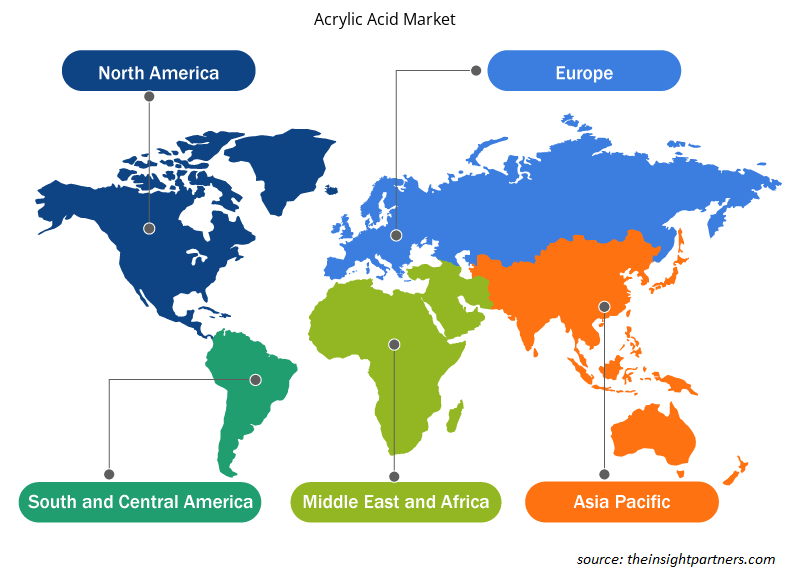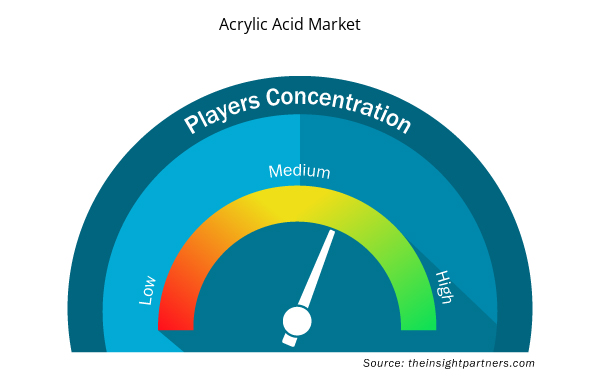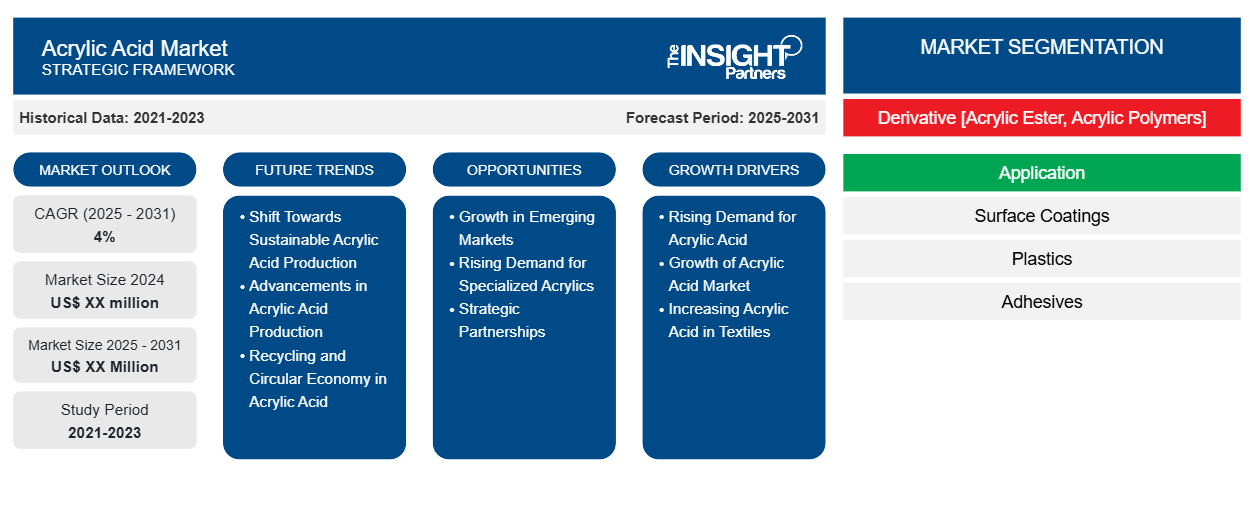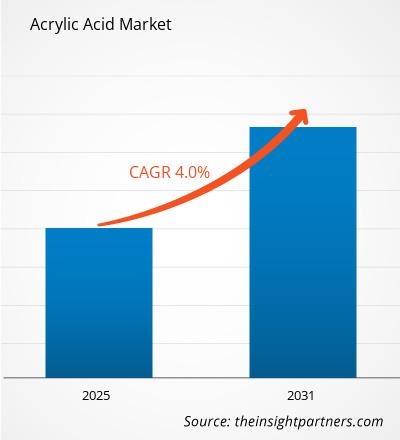Le marché de l'acide acrylique devrait enregistrer un TCAC de 4 % de 2023 à 2031, avec une taille de marché passant de XX millions USD en 2023 à XX millions USD d'ici 2031.
Le rapport sur le marché de l'acide acrylique est segmenté par dérivé [ester acrylique (acrylate de butyle, acrylate de méthyle, acrylate d'éthyle, acrylate de 2-éthylhexyle et autres), polymères acryliques (élastomère acrylique, polymères superabsorbants et autres), et autres]. Le marché est segmenté en fonction de l'application (revêtements de surface, plastiques, adhésifs, peintures, détergents, traitement de l'eau, textile et autres). L'analyse globale est ensuite décomposée au niveau régional et par principaux pays. La taille du marché et les prévisions aux niveaux mondial, régional et national pour tous les segments de marché clés sont couvertes dans le cadre du périmètre. Le rapport offre la valeur en USD pour l'analyse, les segments, les régions et les pays ci-dessus. Le rapport couvre les tendances du marché, ainsi que la dynamique du marché telle que les moteurs, les contraintes et les opportunités clés. Le rapport couvre également le paysage industriel et l'analyse de la concurrence couvrant la concentration du marché, l'analyse de la carte thermique, les principaux acteurs et les développements récents du marché.
Objectif du rapport
Le rapport sur le marché de l'acide acrylique de The Insight Partners vise à décrire le paysage actuel et la croissance future, les principaux facteurs moteurs, les défis et les opportunités. Cela fournira des informations à diverses parties prenantes commerciales, telles que :
- Fournisseurs/fabricants de technologie : pour comprendre l’évolution de la dynamique du marché et connaître les opportunités de croissance potentielles, leur permettant de prendre des décisions stratégiques éclairées.
- Investisseurs : Effectuer une analyse complète des tendances concernant le taux de croissance du marché, les projections financières du marché et les opportunités qui existent tout au long de la chaîne de valeur.
- Organismes de réglementation : Réglementer les politiques et surveiller les activités du marché dans le but de minimiser les abus, de préserver la confiance des investisseurs et de maintenir l’intégrité et la stabilité du marché.
Segmentation du marché de l'acide acrylique
Dérivé [Ester acrylique, polymères acryliques]
Application
- Revêtements de surface
- Plastiques
- Adhésifs
- Peintures
- Détergents
- Traitement de l'eau
- Textile]
Personnalisez ce rapport en fonction de vos besoins
Vous bénéficierez d'une personnalisation gratuite de n'importe quel rapport, y compris de certaines parties de ce rapport, d'une analyse au niveau des pays, d'un pack de données Excel, ainsi que d'offres et de remises exceptionnelles pour les start-ups et les universités.
- Obtenez les principales tendances clés du marché de ce rapport.Cet échantillon GRATUIT comprendra une analyse de données, allant des tendances du marché aux estimations et prévisions.
Facteurs de croissance du marché de l'acide acrylique
- Demande croissante d'acide acrylique : L'acide acrylique monomère est l'un des principaux composants utilisés dans le traitement des polymères superabsorbants, qui sont largement utilisés dans les articles liés à l'hygiène tels que les couches et les serviettes hygiéniques. La croissance rapide de la demande pour ces produits peut être attribuée à la croissance de la population mondiale, à l'augmentation du taux de natalité dans les pays en développement et à la sensibilisation périphérique à l'hygiène personnelle. La demande de polymères superabsorbants augmente à mesure que les utilisateurs finaux incluent des substituts écologiques à haute performance dans les produits de consommation. Cela, à son tour, augmente la consommation d'acide acrylique.
- Croissance du marché de l'acide acrylique : La production de peintures, de revêtements et d'adhésifs intègre également des dérivés de l'acide acrylique en raison de leurs caractéristiques telles que la durabilité, la résistance aux intempéries et la brillance. Les secteurs de la construction et de l'automobile, en particulier dans les pays en développement, génèrent une demande de revêtements de qualité en raison du développement continu de ces secteurs. De plus, l'évolution des préférences vers les produits verts et à faible teneur en COV (composés organiques volatils) a conduit les fabricants à opter pour des produits à base d'acrylique, ce qui augmente le marché global de l'acide acrylique.
- Augmentation de la quantité d'acide acrylique dans les textiles : L'industrie textile utilise des quantités croissantes d'acide acrylique en raison de ses propriétés, telles que le contrôle de l'humidité et la capacité de teinture. Alors que l'industrie de la mode se concentre sur l'adoption de mesures écologiques, l'utilisation de l'acide acrylique dans la création de textiles respirants et imperméables est également en hausse.
Tendances futures du marché de l'acide acrylique
- Vers une production durable d'acide acrylique : de plus en plus d'industries encouragent la durabilité. Les entreprises investissent dans l'utilisation de matières premières respectueuses de l'environnement et dans la chimie verte pour l'approvisionnement en acide acrylique. Cette réorientation fait suite à la recherche de produits plus écologiques par les consommateurs et à l'attention accrue portée aux contrôles environnementaux. Par conséquent, les techniques de production utilisées se concentreront principalement sur une production à faible émission de carbone et une utilisation élevée des ressources.
- Progrès dans la production d'acide acrylique : Le développement de technologies axées sur la production, comme des catalyseurs plus performants et de meilleurs réacteurs, devrait améliorer la production et réduire le coût de production de l'acide acrylique. Ces développements permettraient l'utilisation de différentes matières premières, ce qui renforcerait la concurrence sur le marché.
- Recyclage et économie circulaire dans l'acide acrylique : L'économie circulaire est sérieusement envisagée, car différents secteurs s'efforcent de recycler et d'éliminer les déchets. Sur le marché de l'acide acrylique, il est probable que cela conduira à l'introduction d'une technologie de recyclage pour les produits à base d'acide acrylique, créant ainsi un système en boucle fermée.
Opportunités du marché de l'acide acrylique
- Croissance sur les marchés émergents : L'industrialisation et l'urbanisation rapides dans des régions telles que l'Asie-Pacifique, l'Amérique latine et l'Afrique permettent aux fabricants d'acide acrylique de profiter d'opportunités de marché considérables. Avec la croissance des économies de ces régions, il existe de fortes possibilités d'augmentation de la demande en produits de soins personnels, en produits textiles ainsi qu'en matériaux de construction, ce qui à son tour augmentera l'utilisation de l'acide acrylique.
- Demande croissante en acryliques spécialisés : On observe une tendance croissante à la création de produits acryliques spécialisés adaptés à des utilisations spécifiques, comme les adhésifs, les produits d'étanchéité et les revêtements performants. Ces produits ont tendance à attirer de meilleurs prix sur le marché et à améliorer la rentabilité. Les entreprises qui mettent l'accent sur la recherche et le développement pour proposer de nouvelles formulations d'acryliques pourront accéder à ces petits marchés.
- Partenariats stratégiques : Les partenariats avec d'autres entreprises, des entités de recherche ou des fournisseurs de technologie peuvent créer un potentiel de croissance du marché pour l'acide acrylique. De tels engagements amélioreraient le développement de produits et permettraient de pénétrer de nouveaux marchés grâce à la mise en commun des ressources, des compétences et de la technologie. Les alliances stratégiques aident également les entreprises à faire face aux exigences réglementaires excessives.
Aperçu régional du marché de l'acide acrylique
Les tendances régionales et les facteurs influençant le marché de l’acide acrylique tout au long de la période de prévision ont été expliqués en détail par les analystes d’Insight Partners. Cette section traite également des segments et de la géographie du marché de l’acide acrylique en Amérique du Nord, en Europe, en Asie-Pacifique, au Moyen-Orient et en Afrique, ainsi qu’en Amérique du Sud et en Amérique centrale.

- Obtenez les données régionales spécifiques au marché de l'acide acrylique
Portée du rapport sur le marché de l'acide acrylique
| Attribut de rapport | Détails |
|---|---|
| Taille du marché en 2023 | XX millions de dollars américains |
| Taille du marché d'ici 2031 | XX millions de dollars américains |
| Taux de croissance annuel composé mondial (2023-2031) | 4% |
| Données historiques | 2021-2022 |
| Période de prévision | 2024-2031 |
| Segments couverts | Par dérivé [ester acrylique, polymères acryliques]Par application
|
| Régions et pays couverts | Amérique du Nord
|
| Leaders du marché et profils d'entreprises clés |
|
Densité des acteurs du marché de l'acide acrylique : comprendre son impact sur la dynamique des entreprises
Le marché de l'acide acrylique connaît une croissance rapide, tirée par la demande croissante des utilisateurs finaux en raison de facteurs tels que l'évolution des préférences des consommateurs, les avancées technologiques et une plus grande sensibilisation aux avantages du produit. À mesure que la demande augmente, les entreprises élargissent leurs offres, innovent pour répondre aux besoins des consommateurs et capitalisent sur les tendances émergentes, ce qui alimente davantage la croissance du marché.
La densité des acteurs du marché fait référence à la répartition des entreprises ou des sociétés opérant sur un marché ou un secteur particulier. Elle indique le nombre de concurrents (acteurs du marché) présents sur un marché donné par rapport à sa taille ou à sa valeur marchande totale.
Les principales entreprises opérant sur le marché de l'acide acrylique sont :
- Arkema SA
- BASF SE
- Evonik Industries AG
- Chimie LG
- Société Myriant
Avis de non-responsabilité : les sociétés répertoriées ci-dessus ne sont pas classées dans un ordre particulier.

- Obtenez un aperçu des principaux acteurs du marché de l'acide acrylique
Principaux arguments de vente
- Couverture complète : Le rapport couvre de manière exhaustive l’analyse des produits, des services, des types et des utilisateurs finaux du marché de l’acide acrylique, offrant un paysage holistique.
- Analyse d’experts : Le rapport est compilé sur la base d’une compréhension approfondie des experts et analystes du secteur.
- Informations à jour : Le rapport garantit la pertinence commerciale en raison de sa couverture des informations récentes et des tendances des données.
- Options de personnalisation : ce rapport peut être personnalisé pour répondre aux exigences spécifiques du client et s'adapter parfaitement aux stratégies commerciales.
Le rapport de recherche sur le marché de l’acide acrylique peut donc aider à ouvrir la voie au décodage et à la compréhension du scénario de l’industrie et des perspectives de croissance. Bien qu’il puisse y avoir quelques préoccupations valables, les avantages globaux de ce rapport ont tendance à l’emporter sur les inconvénients.
- Analyse historique (2 ans), année de base, prévision (7 ans) avec TCAC
- Analyse PEST et SWO
- Taille du marché Valeur / Volume - Mondial, Régional, Pays
- Industrie et paysage concurrentiel
- Ensemble de données Excel



Report Coverage
Revenue forecast, Company Analysis, Industry landscape, Growth factors, and Trends

Segment Covered
This text is related
to segments covered.

Regional Scope
North America, Europe, Asia Pacific, Middle East & Africa, South & Central America

Country Scope
This text is related
to country scope.
Questions fréquemment posées
The development of sustainable production practices is expected to be the key market trends.
Based on geography, Asia Pacific held the largest share of the acrylic acid market due to its rapidly growing industries, driving the demand for paints, coatings, and adhesives.
BASF SE, Evonik Industries AG, NIPPON SHOKUBAI CO LTD, Arkema, Dow, LG Chem, SIBUR International GmbH, Mitsubishi Chemical Corporation, Sasol, and Shanghai Huayi Acrylic Acid Co Ltd are the key players operating in the acrylic acid market.
Based on application, the paints segment is expected to witness the fastest growth during the forecast period
The growing demand for superabsorbent polymers is driving the market growth.
The Acrylic Acid Market is estimated to witness a CAGR of 4% from 2023 to 2031
Trends and growth analysis reports related to Chemicals and Materials : READ MORE..
1. Arkema S.A.
2. BASF SE
3. Evonik Industries AG
4. LG Chem
5. Myriant Corporation
6. NIPPON SHOKUBAI CO., LTD
7. SIBUR
8. SUNVIC CHEMICAL
9. The Dow Chemical Company
10. The Lubrizol Corporation
The Insight Partners performs research in 4 major stages: Data Collection & Secondary Research, Primary Research, Data Analysis and Data Triangulation & Final Review.
- Data Collection and Secondary Research:
As a market research and consulting firm operating from a decade, we have published and advised several client across the globe. First step for any study will start with an assessment of currently available data and insights from existing reports. Further, historical and current market information is collected from Investor Presentations, Annual Reports, SEC Filings, etc., and other information related to company’s performance and market positioning are gathered from Paid Databases (Factiva, Hoovers, and Reuters) and various other publications available in public domain.
Several associations trade associates, technical forums, institutes, societies and organization are accessed to gain technical as well as market related insights through their publications such as research papers, blogs and press releases related to the studies are referred to get cues about the market. Further, white papers, journals, magazines, and other news articles published in last 3 years are scrutinized and analyzed to understand the current market trends.
- Primary Research:
The primarily interview analysis comprise of data obtained from industry participants interview and answers to survey questions gathered by in-house primary team.
For primary research, interviews are conducted with industry experts/CEOs/Marketing Managers/VPs/Subject Matter Experts from both demand and supply side to get a 360-degree view of the market. The primary team conducts several interviews based on the complexity of the markets to understand the various market trends and dynamics which makes research more credible and precise.
A typical research interview fulfils the following functions:
- Provides first-hand information on the market size, market trends, growth trends, competitive landscape, and outlook
- Validates and strengthens in-house secondary research findings
- Develops the analysis team’s expertise and market understanding
Primary research involves email interactions and telephone interviews for each market, category, segment, and sub-segment across geographies. The participants who typically take part in such a process include, but are not limited to:
- Industry participants: VPs, business development managers, market intelligence managers and national sales managers
- Outside experts: Valuation experts, research analysts and key opinion leaders specializing in the electronics and semiconductor industry.
Below is the breakup of our primary respondents by company, designation, and region:

Once we receive the confirmation from primary research sources or primary respondents, we finalize the base year market estimation and forecast the data as per the macroeconomic and microeconomic factors assessed during data collection.
- Data Analysis:
Once data is validated through both secondary as well as primary respondents, we finalize the market estimations by hypothesis formulation and factor analysis at regional and country level.
- Macro-Economic Factor Analysis:
We analyse macroeconomic indicators such the gross domestic product (GDP), increase in the demand for goods and services across industries, technological advancement, regional economic growth, governmental policies, the influence of COVID-19, PEST analysis, and other aspects. This analysis aids in setting benchmarks for various nations/regions and approximating market splits. Additionally, the general trend of the aforementioned components aid in determining the market's development possibilities.
- Country Level Data:
Various factors that are especially aligned to the country are taken into account to determine the market size for a certain area and country, including the presence of vendors, such as headquarters and offices, the country's GDP, demand patterns, and industry growth. To comprehend the market dynamics for the nation, a number of growth variables, inhibitors, application areas, and current market trends are researched. The aforementioned elements aid in determining the country's overall market's growth potential.
- Company Profile:
The “Table of Contents” is formulated by listing and analyzing more than 25 - 30 companies operating in the market ecosystem across geographies. However, we profile only 10 companies as a standard practice in our syndicate reports. These 10 companies comprise leading, emerging, and regional players. Nonetheless, our analysis is not restricted to the 10 listed companies, we also analyze other companies present in the market to develop a holistic view and understand the prevailing trends. The “Company Profiles” section in the report covers key facts, business description, products & services, financial information, SWOT analysis, and key developments. The financial information presented is extracted from the annual reports and official documents of the publicly listed companies. Upon collecting the information for the sections of respective companies, we verify them via various primary sources and then compile the data in respective company profiles. The company level information helps us in deriving the base number as well as in forecasting the market size.
- Developing Base Number:
Aggregation of sales statistics (2020-2022) and macro-economic factor, and other secondary and primary research insights are utilized to arrive at base number and related market shares for 2022. The data gaps are identified in this step and relevant market data is analyzed, collected from paid primary interviews or databases. On finalizing the base year market size, forecasts are developed on the basis of macro-economic, industry and market growth factors and company level analysis.
- Data Triangulation and Final Review:
The market findings and base year market size calculations are validated from supply as well as demand side. Demand side validations are based on macro-economic factor analysis and benchmarks for respective regions and countries. In case of supply side validations, revenues of major companies are estimated (in case not available) based on industry benchmark, approximate number of employees, product portfolio, and primary interviews revenues are gathered. Further revenue from target product/service segment is assessed to avoid overshooting of market statistics. In case of heavy deviations between supply and demand side values, all thes steps are repeated to achieve synchronization.
We follow an iterative model, wherein we share our research findings with Subject Matter Experts (SME’s) and Key Opinion Leaders (KOLs) until consensus view of the market is not formulated – this model negates any drastic deviation in the opinions of experts. Only validated and universally acceptable research findings are quoted in our reports.
We have important check points that we use to validate our research findings – which we call – data triangulation, where we validate the information, we generate from secondary sources with primary interviews and then we re-validate with our internal data bases and Subject matter experts. This comprehensive model enables us to deliver high quality, reliable data in shortest possible time.


 Obtenez un échantillon gratuit pour ce rapport
Obtenez un échantillon gratuit pour ce rapport